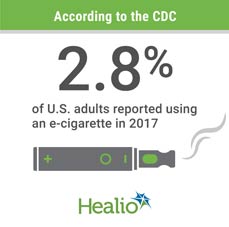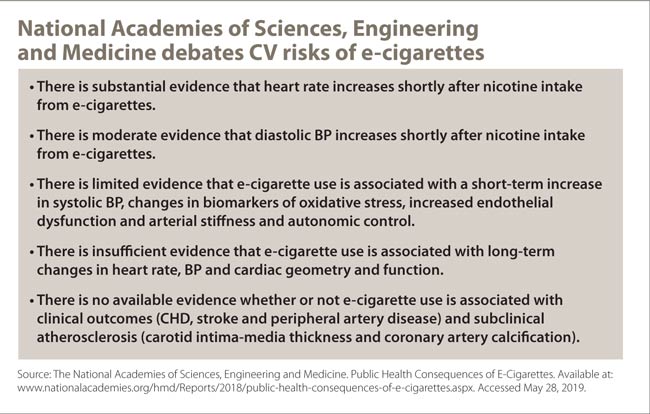Cardiologists grapple with potential CV risks posed by e-cigarettes
Electronic cigarettes, or e-cigarettes, have become increasingly popular since they entered the market in 2006. Use of these alternative devices continues to grow. FAccording to recent CDC data, 2.8% of U.S. adults reported using an e-cigarette in 2017. A big concern is the growing use of e-cigarettes in children and teenagers. In 2018, 3.6 million U.S. middle and high school students reported recent use of e-cigarettes, according to the CDC.
Although research in this area is sparse, emerging data have shown the potential benefit of e-cigarettes such as Juul, in terms of cigarette smoking cessation. In a study published in The New England Journal of Medicine in January, more participants assigned e-cigarettes for smoking cessation abstained from smoking at 1 year compared with a control group in which patients could choose their own nicotine replacement therapy (18% vs. 9.9%; RR = 1.83; 95% CI, 1.3-2.58).
However, benefits to cigarette smoking cessation aside, concerns remain regarding the safety and long-term impact of e-cigarettes.

“One concern is that many people who quit smoking with electronic cigarettes continue to be electronic cigarette users 1 year later, so you’ve traded one nicotine product for the other — maybe a more toxic one for a less toxic one — but you’re not ridding them of the nicotine habit, whereas with other nicotine-replacement therapies, commonly people will quit and eventually use no products,” Michael J. Blaha, MD, MPH, director of clinical research and professor of medicine at the Johns Hopkins Ciccarone Center for the Prevention of Cardiovascular Disease and a Cardiology Today Next Gen Innovator, said in an interview. “Many individuals who fail to quit unfortunately become long-term users of both products.”
Nicotine intake may increase the risk for CVD. Although the amount of nicotine can be adjusted on e-cigarettes, the devices are capable of delivering it in very high quantities.

“The concentration of nicotine in one pod of Juul products is 59 mg/mL, and those pods hold just under 1 mL,” Rose Marie Robertson, MD, FAHA, deputy chief science and medical officer at the American Heart Association and co-director of the AHA Tobacco Regulation and Addiction Center, told Cardiology Today. “It delivers essentially the same amount of nicotine as a pack of cigarettes. Someone using a pod a day is almost a pack-a-day smoker essentially in terms of the nicotine.”
A report published by the National Academies of Sciences, Engineering and Medicine in 2018 concluded that there was no available evidence that links e-cigarette use with clinical CV outcomes or subclinical atherosclerosis, but there was short-term evidence of potential CV harm (Sidebar).

“It doesn’t mean that e-cigarettes are harmless,” Nancy Rigotti, MD, professor of medicine at Harvard Medical School and director of the Tobacco Research and Treatment Center at Massachusetts General Hospital, told Cardiology Today. “But they are clearly less harmful to current smokers than continuing to smoke conventional cigarettes. It’s a matter of comparison. Smokers who switch to e-cigarettes are not exposed to the cardiotoxic products of tobacco combustion. If you’re a smoker, switching over completely to vaping is certainly going to be less risky to your cardiovascular system and to your overall health because you just have less exposure to all the toxic substances in cigarettes.”
Impact on CV health
Data on long-term effects of e-cigarettes are limited due to the fact that the current devices have not been available on the market long enough to perform such studies, experts told Cardiology Today. The devices entered the market as consumer products and were not tested premarket for safety and efficacy as drugs and medical devices are.

“To make a long story short, the jury is still out on the long-term impact of e-cigarettes,” Elizabeth Ratchford, MD, associate professor of medicine at the Johns Hopkins University School of Medicine and director of the Johns Hopkins Center for Vascular Medicine, told Cardiology Today. “There is such a wide variety of products on the market with different chemicals and different strengths and different levels of nicotine, so it’s hard to study and make general conclusions from what’s available.”
With regard to the short-term effects, e-cigarettes have been associated with autonomic dysfunction including heart rate variability and increases in the levels of BP and C-reactive protein, experts said.

“If [users] have these effects for a prolonged period of time, it may lead to cardiovascular disease outcomes such as MI, coronary artery disease or stroke, but there’s no direct causation study which has shown this association,” Mohinder R. Vindhyal, MD, MEd, assistant professor of medicine in the department of internal medicine at the University of Kansas School of Medicine in Wichita, said in an interview.
Studies typically take decades to show these kinds of adverse outcomes, so the absence of evidence now doesn’t mean that these users are safe, Robertson said.
E-cigarettes have been found to have similar types of tobacco-related toxicants, although with lower levels than combustible cigarettes. Despite this, the greatest exposure to these toxins has been observed in people who smoke both e-cigarettes and combustible cigarettes, known as dual users. A study published in JAMA Network Open in 2018 found that people who exclusively smoked e-cigarettes had 10% to 98% lower concentrations of biomarkers associated with nicotine exposure compared with those who exclusively smoked combustible cigarettes. In addition, people who exclusively smoked combustible cigarettes had 10% to 36% lower concentrations of these biomarkers than dual users.
“We can say that there are definitely measurable levels of known cardiovascular toxins in e-cigarettes’ vape,” Blaha said in an interview. “Some of the same things that we see with smoking that lead to cardiovascular disease like acrolein, for example, or other reactive aldehydes, you do see in the vape of electronic cigarette users more than those people who don’t use at all.”
A major component of e-cigarettes that may greatly affect CV function is the presence of flavored e-cigarette liquids used in these devices, which can be purchased or even homemade using recipes accessed online, experts said. In a study published in the Journal of the American College of Cardiology in May, researchers assessed the effects of six of these liquids with varying nicotine concentrations. The study found that the cinnamon flavor was the most potent regarding cytotoxicity and led to endothelial dysfunction compared with other flavors such as fruit, butterscotch, sweet tobacco and menthol.
“The problem with these e-liquids is that there’s no governance overseeing them, hence the compounding of these e-liquids is not regulated,” Vindhyal said. “That’s where the devil lies in the details. You may know what’s in this e-liquid that you’re smoking, but you don’t know what happens to it when it is vaporized and whether it holds the same effects as it was in the liquid form.”
Another use for e-cigarettes that has quickly emerged is for marijuana, although even less is known about the effects on CV health, experts said. A study published in JAMA Network Open in 2018 concluded that vaporized cannabis produces stronger dose-related drug effects compared with smoked cannabis.
“It’s a more efficient deliverer of the THC and had a little bit greater effects on blood pressure and heart rate,” Holly R. Middlekauff, MD, professor of medicine (cardiology), professor of physiology and assistant dean of student affairs at the David Geffen School of Medicine at UCLA, said in an interview.

Current guidelines
Some guidance from professional societies has been published since e-cigarettes entered the market. A policy statement published by the AHA in 2014 recommended short-term use of these products could be considered for smoking cessation if other FDA-approved and regulated products had been tried and had not worked for a patient. Patients should also be informed that the long-term safety of these products is unknown and that they should plan to quit them as well.
“That guidance said more or less what we would say now,” Rigotti said. “Everyone agrees that you should use existing FDA-approved medications that we know are safe and effective first, but the AHA said it’s not unreasonable to considering recommending e-cigarettes if FDA-approved medications don’t work, and to be prepared to inform patients about their risks and benefits.”
The policy statement also recognized that the level of some constituents in e-cigarettes is much lower than in combustible cigarettes, which may contribute to harm reduction if a person were to switch from combustible cigarettes to e-cigarettes. With this information, the AHA recommended that e-cigarettes should be regulated like other tobacco products.
The ACC published an expert consensus decision pathway on smoking cessation in JACC in 2018. The document also emphasized the importance of short-term use of these devices for smoking cessation if other FDA-approved methods are unsuccessful. In addition, the ACC recommended that combustible cigarettes and e-cigarettes should not be used interchangeably. A policy statement from the American Academy of Pediatrics in 2015 also recognized the highly addictive components of e-cigarettes in young patients and recommends the regulation of these products.

It is important for cardiologists to keep up to date on the available data, societal recommendations and, potentially, forthcoming guidelines when it comes to steering their patients in the right direction regarding smoking cessation.
“It is incumbent upon us and the medical community to be informed about the risks and the potential benefits and to be able to advise patients, because if you surveyed a bunch of doctors, asking where’s the best place to get electronic cigarettes or what’s the best brand, or which one is most reliable, most people have no idea,” Ratchford said.
‘We need to know more’
Many have called for more research on e-cigarettes such as Juul, which have become particularly prevalent among young users, and the pharmacology involved in the use of these products.
“A major difference between Juul and Juul-like products and previous e-cigarettes is the use of nicotine salts which appears to result in more rapidly achieved and higher levels of nicotine,” Robertson said in an interview. “We need to know more about what that does in terms of addictive potential, so understanding the pharmacokinetics and pharmacodynamics of providing nicotine in different ways is important.”
Another area of research is focus on the activation of certain biomarkers before and after e-cigarette use such as oxidative stress markers, abnormal endothelial function and inflammatory markers.
“That would give us a lot of information, but those are tough studies to do; it is tough to recruit the population,” Middlekauff said in an interview. “About half of people who use electronic cigarettes also use tobacco cigarettes, but those kinds of studies would be very helpful until we have the longitudinal studies.”
Blaha works with the AHA Tobacco Regulation and Addiction Center, which is funded by the FDA to conduct more research. At the moment, the center is conducting several projects including acute exposure studies, clinical studies and large epidemiologic studies to learn more about toxic exposure, hemodynamic and other CV measures and the habits of patients who use e-cigarettes.
More research is also warranted to investigate the flavors that are used in e-cigarettes. Although generally recognized as safe to be added to food by the FDA, that does not mean that the flavors are safe to inhale, experts said, and a number of studies have shown direct toxic effects of these flavors on multiple kinds of human cells.
The effectiveness of e-cigarettes to help people quit smoking is another area of research, experts said. Very little data from the United States have demonstrated the benefits of these devices due to strict FDA regulations, although international trials have shown benefits of e-cigarettes for smoking cessation.
“It took us a while to figure out what is the best way for us to use nicotine replacement products. With vaping, these products are new, so we’re still on the learning curve to figure out what’s the best way for them to be effective,” Rigotti told Cardiology Today.

All of this research put together and the ability to make the devices and ingredients more uniform may make it easier for the FDA to regulate these products.
The FDA is also conducting its own research through the Center for Tobacco Products and Center for Drug Evaluation and Research to assess four types of electronic nicotine delivery systems with three different flavors: a tank-style device, a pen-style device, a device that looks like a cigarette and a pod-style device.
“The agency will conduct toxicity studies with some or all of the four types of products and will seek to develop and provide additional information concerning the toxicity of these products,” former FDA commissioner Scott Gottlieb, MD, and Amy Abernethy, MD, PhD, principal deputy commissioner of the FDA, wrote in a column posted on the FDA’s website. “We need to fully evaluate these potential risks to inform the public as well as our own regulatory decision-making.”
The cardiologist’s role
Given the current knowledge base and experience with e-cigarettes, it is understood that there are risks and benefits associated with use of these products. Experts suggest that health care providers should consider whether the risk for short-term use of these devices is worth it in order to wean off combustible cigarettes, especially when other attempts with FDA-approved products have failed.
“If there’s anything you can do to get off of the combustible cigarettes, then it’s probably worth the risk honestly because if it’s only for short term, it’s probably OK,” Ratchford said in an interview. “The whole idea is that if you use it for the short term and then you taper off, hopefully the long-term effects would be minimal compared to continuing with regular smoking.”
The risks of these devices are not only derived from the materials that are inhaled, but also from the marketing to such young people, experts said.
“The majority of all users are young people and a swath of those people have never used tobacco products before,” Blaha said. “These appear to amount to a net public health harm, but if you just look at the cigarette smokers, yes, there is some moderate evidence that e-cigarettes lead to smoking cessation on top of or beyond that seen with other nicotine-replacement therapies. In those particular patients, of which I have many in my clinic, we probably get a large individual health benefit.”
Cardiologists can play a role in helping patients who want to quit smoking by collecting more information within their electronic medical records.
“We need to know how much nicotine or how many cartridges they’re using,” Ratchford said. “We need to have a way to gauge their progress. Some people will use them and have zero nicotine, which is interesting. That is not good because you’re done with this nicotine withdrawal issue, but you’re still inhaling some chemicals.”
It is also important to counsel patients on the best way to quit smoking, whether it be with e-cigarettes or other methods.
“In 2019, doctors need to be familiar with electronic cigarettes and know that they’re one option for their adult smokers who have cardiovascular disease to quit smoking,” Blaha said. – by Darlene Dobkowski
- References:
- Barua RS, et al. J Am Coll Cardiol. 2018;doi:10.1016/j.jacc.2018.10.027.
- Bhatnagar A, et al. Circulation. 2014;doi:10.1161/CIR.0000000000000107.
- CDC. Electronic Cigarettes. Available at: www.cdc.gov/tobacco/basic_information/e-cigarettes/index.htm. Accessed May 29, 2019.
- FDA. Understanding the Health Impact and Dangers of Smoke and ‘Vapor.” Available at: www.fda.gov/news-events/fda-voices-perspectives-fda-experts/understanding-health-impact-and-dangers-smoke-and-vapor. Accessed May 28, 2019.
- Goniewicz ML, et al. JAMA Netw Open. 2018;doi:10.1001/jamanetworkopen.2018.5937.
- Hajek P, et al. N Engl J Med. 2019;doi:10.1056/NEJMoa1808779.
- Lee WH, et al. J Am Coll Cardiol. 2019;doi:10.1016/j.jacc.2019.03.476.
- The National Academies of Sciences, Engineering and Medicine. Public Health Consequences of E-Cigarettes. Available at: www.nationalacademies.org/hmd/Reports/2018/public-health-consequences-of-e-cigarettes.aspx. Accessed May 28, 2019.
- Spindle TR, et al. JAMA Netw Open. 2018;doi:10.1001/jamanetworkopen.2018.4841.
- Walley SC, et al. Pediatrics. 2015;doi:10.1542/peds.2015-3222.
- For more information:
- Michael J. Blaha, MD, MPH, can be reached at mblaha1@jhmi.edu; Twitter: @michaeljblaha.
- Holly R. Middlekauff, MD, can be reached at hmiddlekauff@mednet.ucla.edu.
- Elizabeth Ratchford, MD, can be reached at evr@jhmi.edu; Twitter: @evratchford.
- Nancy Rigotti, MD, can be reached at nrigotti@partners.org.
- Rose Marie Robertson, MD, FAHA, can be reached at rosemarie.robertson@heart.org.
- Mohinder R. Vindhyal, MD, MEd, can be reached at mvindhyal@hotmail.com; Twitter: mvreddy_md.
Disclosures: Middlekauff, Ratchford, Robertson and Vindhyal report no relevant financial disclosures. Blaha reports he receives grant funding from the FDA as part of the AHA Tobacco Regulation and Addiction Center. Rigotti reports she has consulted without pay for Pfizer, which makes a smoking cessation medication.
